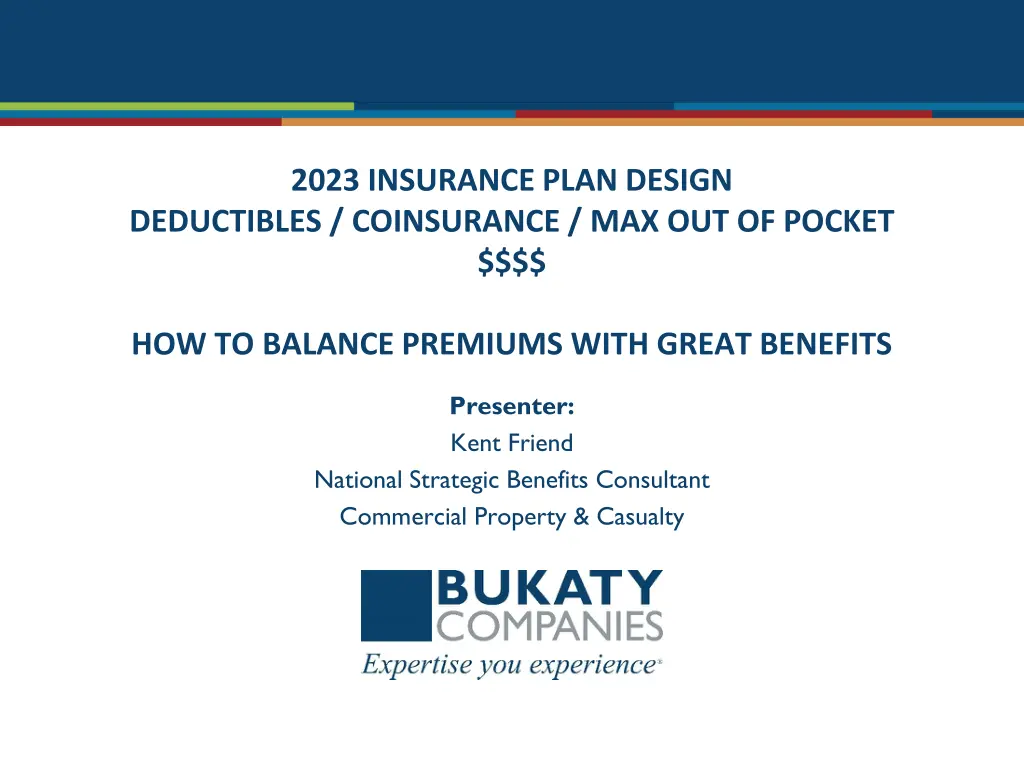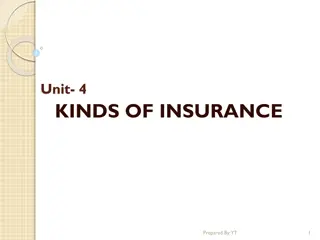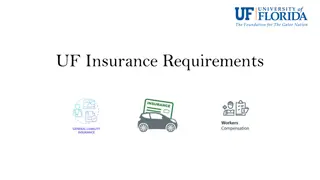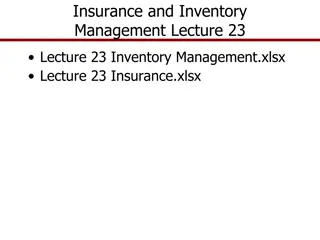
Balancing Insurance Plan Design for Optimal Premiums and Benefits
Learn how to effectively balance insurance plan deductibles, coinsurance, and maximum out-of-pocket expenses to optimize premiums while providing great benefits. Join Kent Friend, a National Strategic Benefits Consultant, as he shares insights on taking a strategic approach, understanding cost drivers, and industry statistics impacting employee health care coverage. Gain valuable knowledge on managing medical cost spend factors and industry trends to make informed decisions for your organization's insurance plans.
Download Presentation

Please find below an Image/Link to download the presentation.
The content on the website is provided AS IS for your information and personal use only. It may not be sold, licensed, or shared on other websites without obtaining consent from the author. If you encounter any issues during the download, it is possible that the publisher has removed the file from their server.
You are allowed to download the files provided on this website for personal or commercial use, subject to the condition that they are used lawfully. All files are the property of their respective owners.
The content on the website is provided AS IS for your information and personal use only. It may not be sold, licensed, or shared on other websites without obtaining consent from the author.
E N D
Presentation Transcript
2023 INSURANCE PLAN DESIGN DEDUCTIBLES / COINSURANCE / MAX OUT OF POCKET $$$$ HOW TO BALANCE PREMIUMS WITH GREAT BENEFITS Presenter: Kent Friend National Strategic Benefits Consultant Commercial Property & Casualty
AGENDA Bukaty Companies overview Take a Strategic Approach Cost Drivers Stats Company funding of premiums Terms Plan Designs contact information Q&A
BUKATY COMPANIES 30 Years in Business Locally owned & operated Financially strong 275+ Employees 6 Divisions Licensed in all 50 states o Employee Benefits o HR Consulting o Benefit Administration o Property & Casualty o Payroll & Accounting Services o 401(k) & Wealth Management Top producer designations o BCBS of KC Blue Chip Cigna Platinum Producer o Aetna Super Elite o Humana Leaders Club o United Healthcare Platinum 5
INDUSTRY STATISTICS 98% of employers offer health care coverage for their employees1, REPORTING of those o 24% offer an HDHP/HRA or an HSA qualified HDHP, or both2 o 75% of employers offer wellness resources and/or a general wellness program3 The average total employee health care premium per employee in 2022 was $574 per month/ family $1,634 Medical cost trend is predicted to be 6% in 2021(some say 10-12%) Employee benefits make up approximately one-third of total compensation costs3 More than two-thirds of employers increased their benefit offerings to retain employees in the last 12 months3 1SHRM 2017-20 Health Care Benchmarking Report 2Kaiser/HRET Survey of Employer-Sponsored Health Benefits, 2017-20 3SHRM 2018-20 Employee Benefits Report 4PWC Medical Cost Trend: Behind the numbers 2019-20
HEALTH INSURANCE PREMIUMS AND WORKER CONTRIBUTIONS In 2021, the average annual premiums for employer-sponsored health insurance are $7,739 for single coverage and $22,221 for family coverage [Figure A]. The average single and family premiums increased 4% over the past year. During this period, workers wages increased 5% and inflation increased 1.9%.2 The average premium for family coverage has increased 22% over the last five years and 47% over the last ten years [Figure A]. Covered workers in small and large firms have similar premiums for single coverage ($7,813 vs. $7,709) and family coverage ($21,804 vs. $22,389). The average premiums for covered workers in firms with a relatively large share of lower-wage workers (where at least 35% of the workers earn $28,000 annually or less) are lower than the average premiums for covered workers in firms with a smaller share of lower-wage workers for single coverage ($7,156 vs. $7,796) and family coverage ($20,315 vs. $22,407)3. The average premiums for covered workers in high-deductible health plans with a savings option (HDHP/SO) are lower that the overall average premiums for single coverage ($7,016) and family coverage ($20,802) [Figure B]. In contrast, the average premiums for covered workers enrolled in PPOs are higher that the overall average premiums for single ($8,092) and family coverage ($23,312). 7
FUNDING & CONTRIBUTION Average premium for single coverage in 2022 is $6,900 per year REPORTING Average premium for family coverage in 2022 is $20,100 per year Distribution of percentage of premium paid by covered workers for single and family coverage, by firm size, 2022
Terms Deductible- The amount a person has to pay towards medical procedures before the Insurance carrier starts to pay. Coinsurance- That is the percentage you pay and the percentage the Carrier pays of each medical bill. 100% 80/20 70/30 50/50 Max Out of Pocket- The total amount of money one would spend for all medical costs for the year though insurance. Inpatient Medical expenses incurred while getting treatment in a hospital overnight stay usually Out-Patient Medical expenses incurred while getting treatment in a surgical center no overnight 11
Terms Pharmacy The cost the employee pays for prescription drugs Tier 1 Generic Tier 2 Brand Name Tier 3 Specialty drugs Tier 4 Infusion Drugs Retail Pharmacy You pick up your medications monthly at the local pharmacy. Mail order Pharmacy- Usually, a 15% to 30% savings by signing up for mail order, auto refills for maintenance drugs. 12
Terms Age Rated Composite Rated In Network Benefits Providers / Facilities that agrees to work with your insurance carrier and gives a bigger discount than network providers Premiums based on the employee age Premiums based on underwriting Out of Network Benefits Providers / Facilities that do not accept your insurance Warning do not go to Out of Network providers or facilities 13
Terms Tiers EE Employee ES - Employee & Spouse EC - Employee & Child (ren) FAM Employee & Spouse + Child (ren) 14
Ways to Cut Costs 1) Align with Broker who has access to special products 2) Shop all Carriers 3) Change plan style / design a. level funded b. self insured c. direct contracting d. referenced based pricing 4) Raise Deductibles / lower coinsurance percentage 5) Steer usage to lower cost / better outcome providers 6) Use a GAP strategy 7) Use an HRA = Health Reimbursement arrangement 8) Reward Good Behavior put in wellness program = yearly physicals, non- smoking incentives 15
Selecting the Right Providers The old way of using a large network is soon to be obsolete. Narrow Networks & selected specialty providers are gaining in popularity. This is being driven by the sheer economics of the old system .is becoming non affordable! The good news is hospital systems are starting to allow alternate funding arrangements for Self-insured plans and in some cases are offering their own very limited medical plan programs. If you still use the major carrier programs, make sure to evaluate their narrow network options. Make sure to consider plans with no out of network benefits. 16
Plan Types Fully-Insured Level-Funded Self-Insured Reference-Based Pricing Direct Contracting Captive 17
Level-Funded Plan Design A plan design that allows you to have composite rates for groups with less than 50 people on the Medical Insurance. A portion of the premium goes to Insurance overhead and the rest goes towards paying claims. No extra risk to the Company or Employee Locked in premiums for the plan year If there is money left in the claims bucket then the group gets all or a portion of that back - (depending on each carrier) 18
Direct Contract Plan Design A plan design that allows you to Bypass the insurance carriers. Only works for Partially Self-Insured groups. A fee agreement /schedule is negotiated directly with the Hospital(s) and the TPA (Third Party Administrator) pays the claims. The fee agreement is typically 1.5 to 1.75 X the Medicare reimbursement rate. The BUCA rate reimbursement to the Providers is Around 3 X Medicare Providers accept this form of payment because they get more volume and get paid quicker= less hassle / less man hours. 19
Reference-Base Pricing Design A plan design that allows you to Bypass the insurance carriers. Only works for Partially Self-Insured groups. A fee agreement /schedule is determined by CMS data (what hospitals are accepting overall / and what the TPA thinks that they will accept. The fee agreement is typically 1.75 X the Medicare reimbursement rate. No real network Providers may not accept this and can possibly balance bill the employee. Providers accept this form of payment because they get more volume and get paid quicker= less hassle / less man hours. Growing in popularity 20
Gap Insurance Plan Design A plan design that allows you to Raise your medical plan s deductible and Max out of Pocket up, then fill in that Gap with GAP insurance. Its like an HRA = Health Reimbursement arrangement Works great with fully insured & level funded groups & age rated plan designs. Need to have at least 5 people sign up for this. Not all Brokers can offer this. When used it typically saves the company / employee $50 to $100 of premium per person per month. 21
HRA Plan Design A plan design that allows you to Raise your medical plan s deductible and Max out of Pocket up, then fill in that with the Employer paying a set amount of money It can be Company Administered or a TPA can administer this A person either gets a debit card to use for the amount of medical claims the company is willing to pay or the employee submits receipts to get reimbursed. Works great with fully insured & level funded groups & age rated plan designs. Can be a great benefit for the employee. 22
CONTACT Kent Friend National Strategic Benefits Consultant Property & Casualty Consultant kfriend@bukaty.com P: 913.777.7535 C: 816.803.7406 F: 913.345.2608 To receive more information, please call or email me:






















